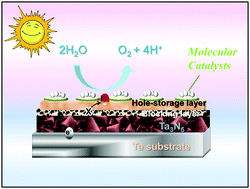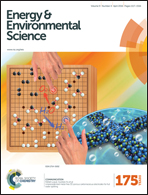Enabling an integrated tantalum nitride photoanode to approach the theoretical photocurrent limit for solar water splitting†
Abstract
The feasibility of photoelectrochemical (PEC) water-splitting cells relies on the development of high-performance photoanodes. Significant progress has been made in the discovery of narrow bandgap semiconductors as promising photoanodes. However, the rational design of photoanode architecture that brings the potentials of narrow bandgap semiconductors into fruition for efficient PEC water oxidation still remains a key challenge. Herein, we show a highly efficient photoanode system consisting of a tantalum nitride (Ta3N5) semiconductor for light harvesting, hole-storage layers (Ni(OH)x/ferrhydrite) that mediate interfacial charge transfer from Ta3N5 to coupled molecular catalysts (Co cubane and Ir complex) for water oxidation and a TiOx blocking layer that reduces the surface electron–hole recombination. The integrated Ta3N5 photoanode exhibits a record photocurrent of 12.1 mA cm−2 at 1.23 V vs. the reversible hydrogen electrode (RHE), which is nearly its theoretical photocurrent limit under sunlight (12.9 mA cm−2), suggesting that almost each pair of photogenerated charge carriers in Ta3N5 has been efficiently extracted and collected for solar water splitting.


 Please wait while we load your content...
Please wait while we load your content...